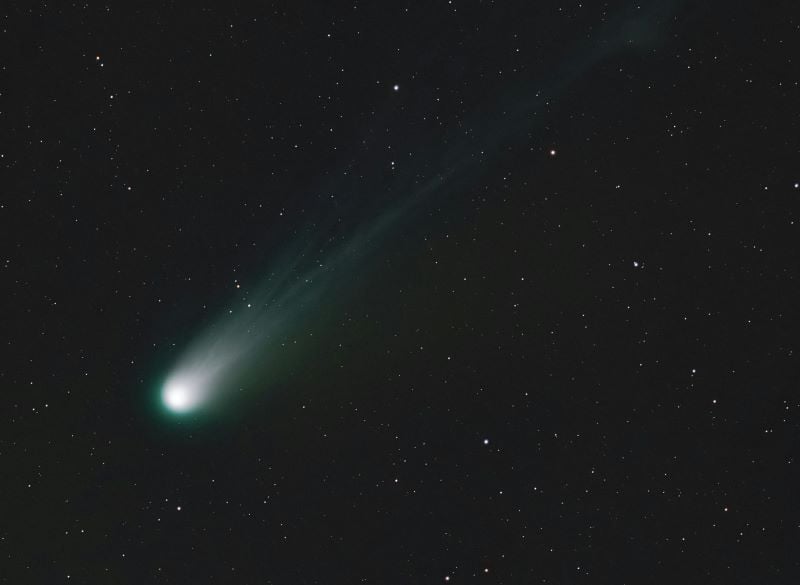
'Brightest Comet of 2025' to light up January – But may be difficult to see
Stargazers worldwide are preparing for the arrival of comet C/2024 G3 (ATLAS), anticipated to be the brightest comet of 2025. Following a year filled with celestial spectacles such as eclipses, meteor showers, and auroras, this cosmic event is poised to capture imaginations early in January. The comet is scheduled to reach perihelion—its closest point to the sun—on 13 January 2025, approaching within 13.5 million kilometres of our star. This proximity places it significantly closer than Mercury, which orbits the sun at an average distance of 47 million kilometres. On the same day, comet G3 will also come closest to Earth, offering observers their brightest view of the icy traveller. Southern hemisphere’s celestial advantage Astronomers suggest that visibility will largely favour the Southern Hemisphere. If the comet survives its close encounter with the sun, it could shine as brightly as Venus, achieving a magnitude of -4.5. It is expected to appear in the Sagittarius constellation, making it a striking addition to the evening sky. However, the comet's survival is not guaranteed. Its unusually close approach to the sun could cause it to disintegrate. Nick James, director of the British Astronomical Association's comet section, explained, “It will be strongly heated and may not survive. But if it does, it could become an impressive object in the evening sky from the Southern Hemisphere after perihelion.” Encouragingly, the comet’s orbital trajectory indicates it last visited the inner solar system approximately 160,000 years ago, suggesting it may have withstood a similar encounter in the past. Observational challenges Even if the comet survives, observing it may pose challenges. Its proximity to the sun increases the risk of dangerous viewing conditions. James cautioned that attempts to observe the comet should only be made by experienced astronomers. Adding to the complexity, moonlight may interfere with viewing around the time of perihelion. The full "Cold Moon" on 13 January will rise opposite the comet in the eastern sky, potentially diminishing its visibility. However, as the moon rises approximately 50 minutes later each subsequent night, conditions for post-sunset observations will gradually improve. Discovery and origin Comet C/2024 G3 (ATLAS) was first identified on 5 April 2024 by the Asteroid Terrestrial-impact Last Alert System (ATLAS), a network of telescopes dedicated to detecting celestial bodies near Earth. Originating from the Oort Cloud—a spherical shell of icy objects surrounding the solar system—the comet represents a rare opportunity to witness an ancient visitor from the outer reaches of our cosmic neighbourhood. As the comet prepares for its fiery journey past the sun, enthusiasts are hopeful for a spectacular display. Whether it thrives or fades in the face of solar heat, comet G3 promises to be a highlight of 2025’s astronomical calendar.

Stargazers worldwide are preparing for the arrival of comet C/2024 G3 (ATLAS), anticipated to be the brightest comet of 2025. Following a year filled with celestial spectacles such as eclipses, meteor showers, and auroras, this cosmic event is poised to capture imaginations early in January. The comet is scheduled to reach perihelion—its closest point to the sun—on 13 January 2025, approaching within 13.5 million kilometres of our star. This proximity places it significantly closer than Mercury, which orbits the sun at an average distance of 47 million kilometres. On the same day, comet G3 will also come closest to Earth, offering observers their brightest view of the icy traveller. Southern hemisphere’s celestial advantage Astronomers suggest that visibility will largely favour the Southern Hemisphere. If the comet survives its close encounter with the sun, it could shine as brightly as Venus, achieving a magnitude of -4.5. It is expected to appear in the Sagittarius constellation, making it a striking addition to the evening sky. However, the comet's survival is not guaranteed. Its unusually close approach to the sun could cause it to disintegrate. Nick James, director of the British Astronomical Association's comet section, explained, “It will be strongly heated and may not survive. But if it does, it could become an impressive object in the evening sky from the Southern Hemisphere after perihelion.” Encouragingly, the comet’s orbital trajectory indicates it last visited the inner solar system approximately 160,000 years ago, suggesting it may have withstood a similar encounter in the past. Observational challenges Even if the comet survives, observing it may pose challenges. Its proximity to the sun increases the risk of dangerous viewing conditions. James cautioned that attempts to observe the comet should only be made by experienced astronomers. Adding to the complexity, moonlight may interfere with viewing around the time of perihelion. The full "Cold Moon" on 13 January will rise opposite the comet in the eastern sky, potentially diminishing its visibility. However, as the moon rises approximately 50 minutes later each subsequent night, conditions for post-sunset observations will gradually improve. Discovery and origin Comet C/2024 G3 (ATLAS) was first identified on 5 April 2024 by the Asteroid Terrestrial-impact Last Alert System (ATLAS), a network of telescopes dedicated to detecting celestial bodies near Earth. Originating from the Oort Cloud—a spherical shell of icy objects surrounding the solar system—the comet represents a rare opportunity to witness an ancient visitor from the outer reaches of our cosmic neighbourhood. As the comet prepares for its fiery journey past the sun, enthusiasts are hopeful for a spectacular display. Whether it thrives or fades in the face of solar heat, comet G3 promises to be a highlight of 2025’s astronomical calendar.
